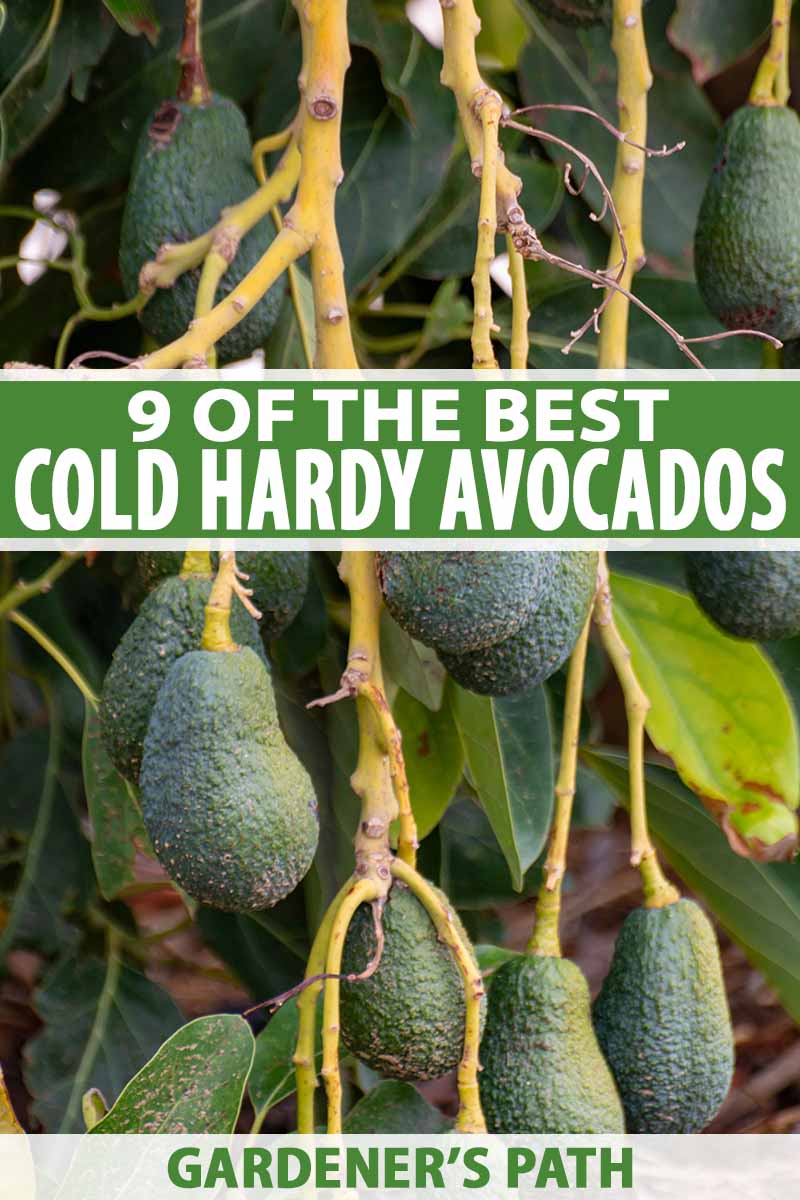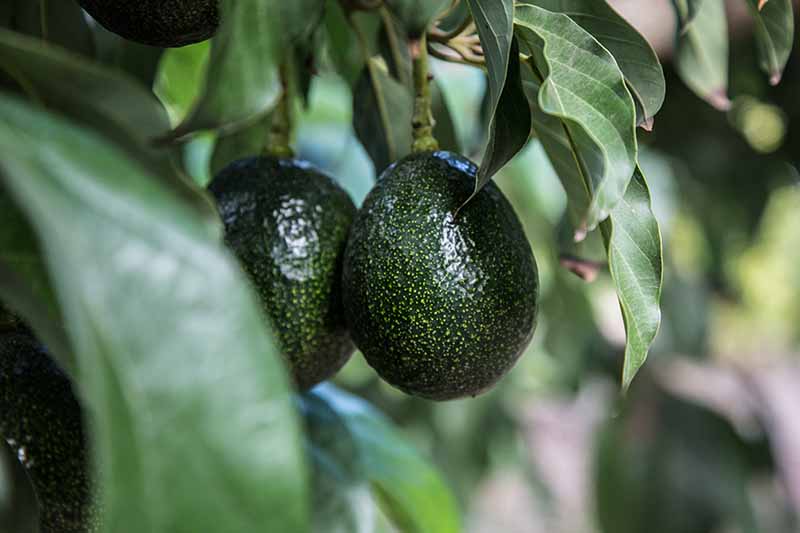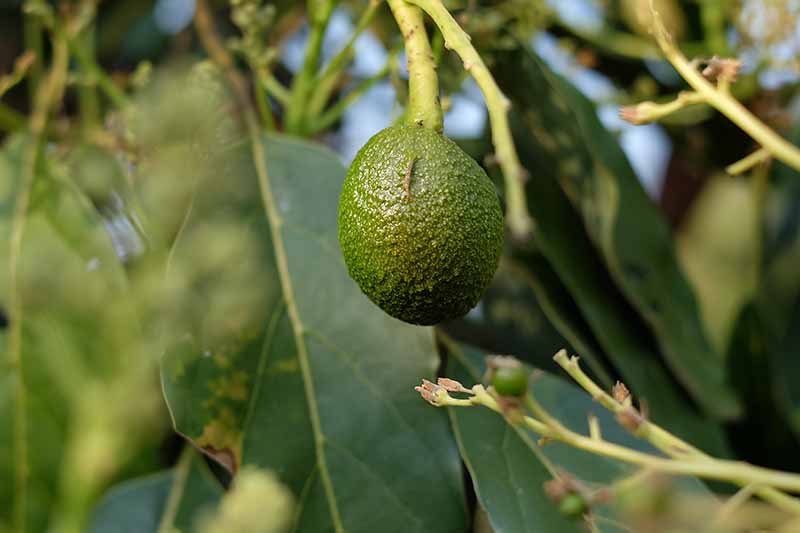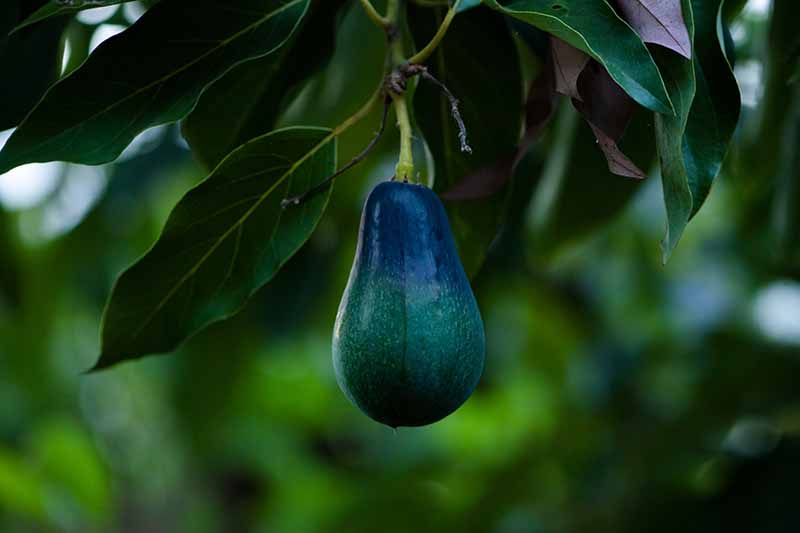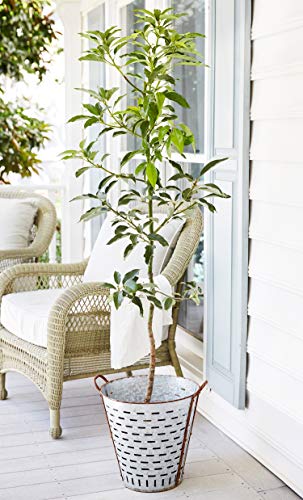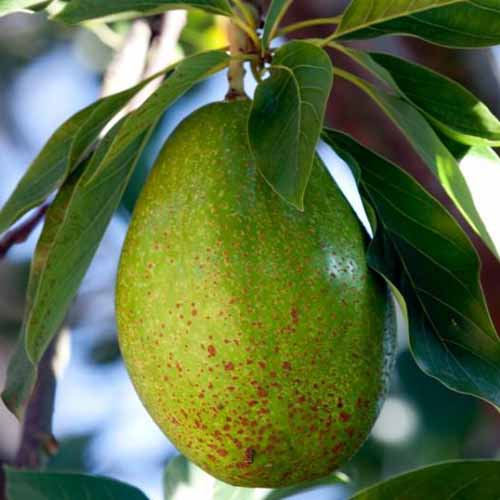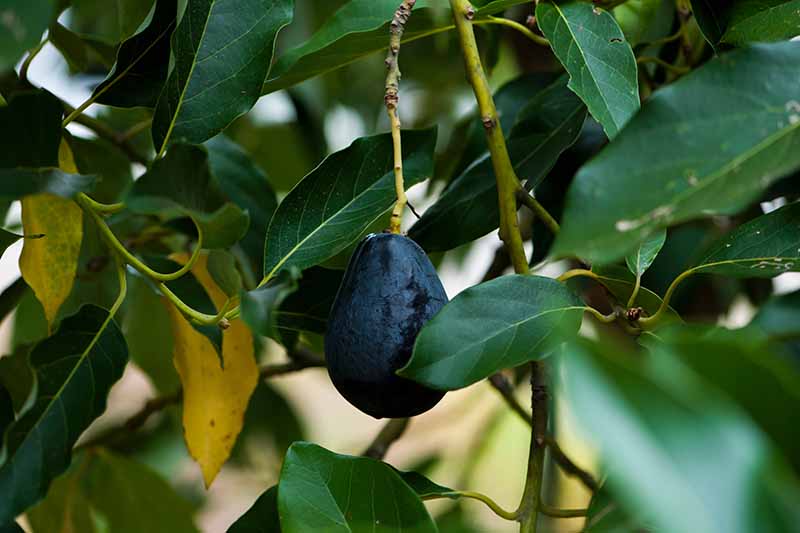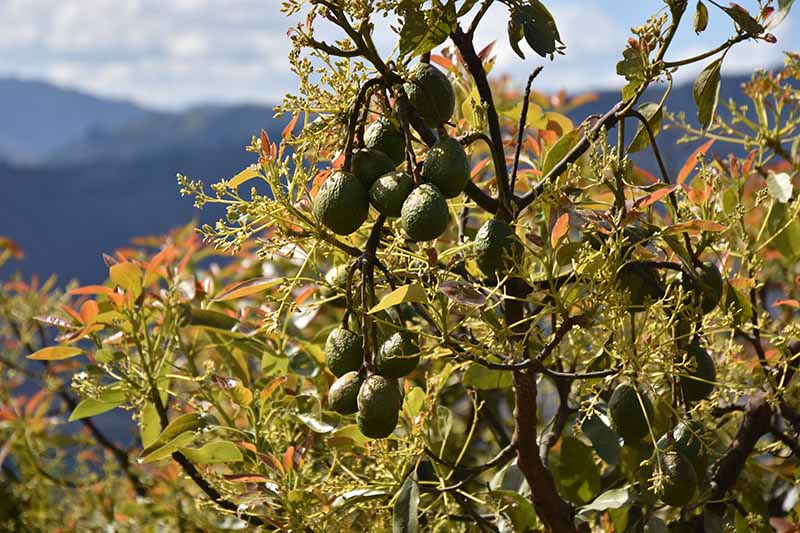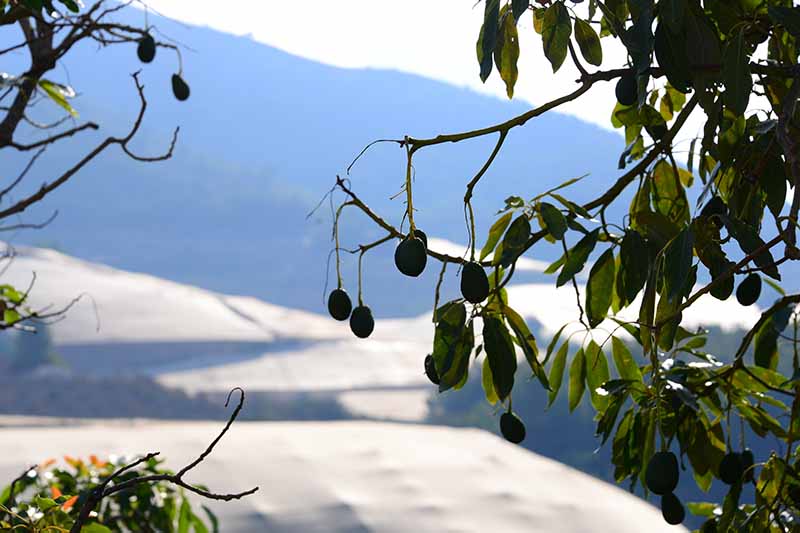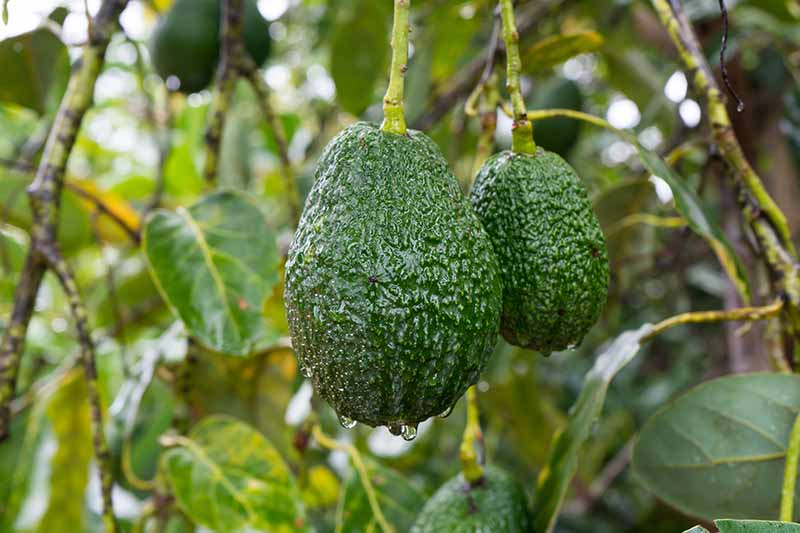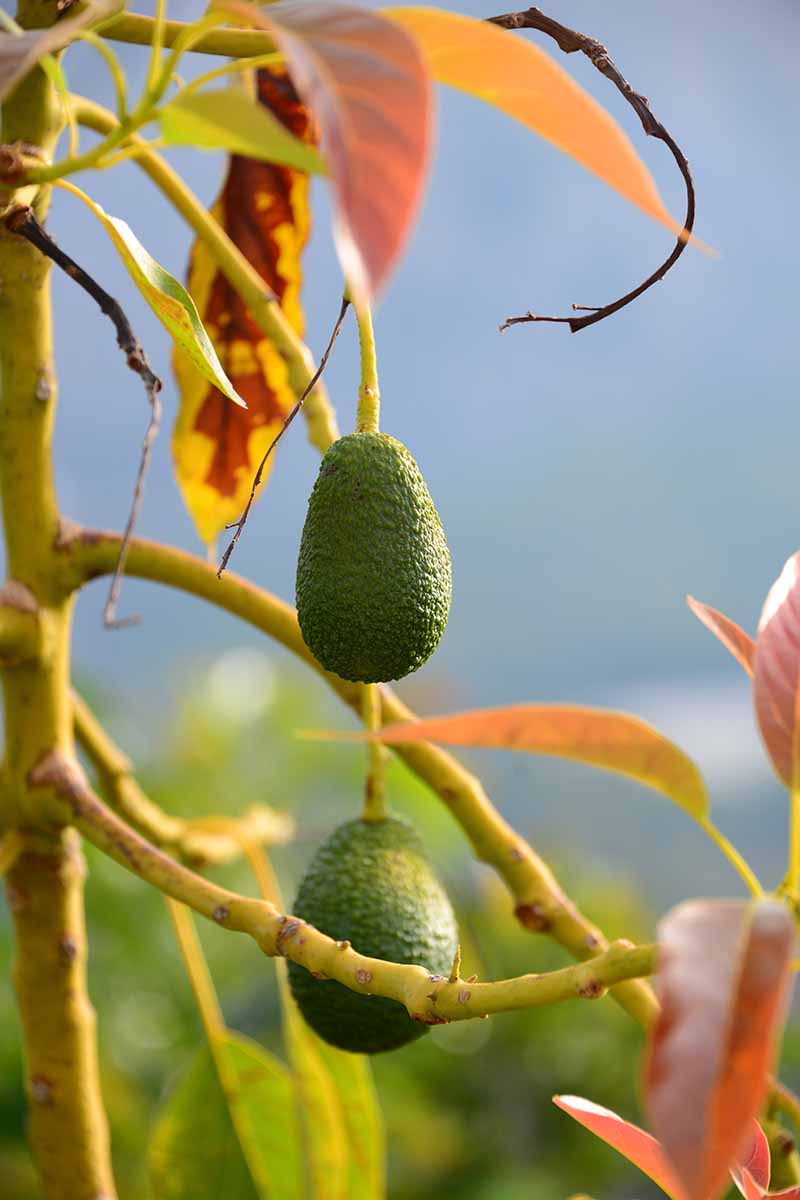Don’t give up hope! The good news is that there are some cold-hardy cultivars available. Of the three subspecies (more on this later) of avocado, the least commonly grown one – the Mexican variety – has a number of cultivars that can tolerate frosts. Some even down to 15°F. We link to vendors to help you find relevant products. If you buy from one of our links, we may earn a commission. If you live in Zone 7 or below, you would need a large greenhouse to successfully grow an avocado tree. Having conducted lab research on avocado trees for 14 years, I am often asked what varieties will grow in colder areas, and I am delighted to provide this guide to answer that question.
A Quick Avocado Primer
Avocado trees fall into one of three possible subspecies: West Indian, Guatemalan, or Mexican. Subspecies are a broader classification than varieties or cultivars. They encompass plants (or animals) that have developed in response to their natural environment in isolation from other populations of the species.
Of the three, the West Indian type is the least tolerant to cooler climates, and the Mexican – and some Mexican hybrids – are the most cold hardy. Let’s look at the avocados you are probably most familiar with first: Hass avocados. These are the ones that turn black when they are ripe, and are the most popular variety for making guacamole during the Super Bowl. They are from the Guatemalan group.
Hass is the most commonly consumed avocado on the US mainland. However, this type does not like the cold. They can tolerate temperatures down to about 25°F, but they won’t be happy. They will drop their flowers, and more dramatically, their leaves. Limbs can be damaged too, but such damage will not become apparent for several months. In southern Florida, avocados of the West Indian subspecies are grown. These have smooth, green fruit and are quite different from the Hass variety. Because they contain less oil, some people don’t find them as tasty. West Indian avocados are sometimes marketed as “slimcados.” One advantage of this particular fruit is that with its lower oil content, it holds its shape better when sliced. This makes it popular for use in salads or tacos.
The West Indian varieties are the most cold-sensitive and can suffer severe damage at temperatures under 30°F. Avocados from the Mexican group are primarily grown in home gardens in the US – not commercially. Many of them are quite tasty and have the added benefit of being cold tolerant. These are not well suited to commercial production. The fruits are thin skinned and are easily damaged. They have a very short period of ripeness, and they don’t hang on the tree for very long. You need to eat them as soon as they are ready.
However, if winter temperatures in your area often dip to 20°F or below, and you want to grow delicious avocados, your best option is a cultivar from the pure Mexican subspecies.
Pure Mexican Cultivars
The fruit from these varieties that originate in the northern Mexican highlands are smaller than most of the commercial ones we’re familiar with. But with their high oil content, they taste exceptionally good. Even their thin, smooth skins are edible. Yep, you sure can. The old tooth pick trick has fascinated kids for years. But you probably won’t get a tree that produces very good fruit. All of the ones that are in commercial production and most backyard examples are from grafted stock.
The leaves typically smell like licorice or anise when crushed. Most varieties of this group can handle cold snaps down to around 18°F.
1. Del Rio (Pryor)
This cultivar appears to be the most cold tolerant – and the most fabulous tasting – type of the Mexican subspecies.
While these fruits are small, weighing only 3-4 ounces, they are reputed to have the richest flavor and highest oil content of all the Mexican types. According to avocado aficionado Craig Hepworth, the Florida Fruit Geek, these trees can handle temperatures down to about 15°F and still produce fruit the next season. The original tree is in Del Rio, Texas. It’s been reported that this tree was frozen back to the major limbs when 7°F temperatures hit in the 1980s. However, it re-sprouted and grew back into a fruiting tree. ‘Del Rio’ was trademarked as ‘Pryor’ by cold-hardy avocado specialist Bill Schneider, who owns Devine Avocados in Texas. This variety is sometimes sold as ‘Fantastic,’ but it is not always the same cultivar.
2. Mexicola Grande
With thin, glossy black skin, the fruit from the ‘Mexicola Grande’ variety is easy to peel, with a delicate flavor. ‘Mexicola Grande’ A fast growing evergreen, these trees can grow up to thirty feet tall. One of the hardiest of all the cultivars, trees are reported to tolerate temperatures into the low 20s.
3. Opal (Lila)
The ‘Opal’ variety originates in Texas. It produces medium-sized green fruits with a creamy flavor that are slightly larger than most of the Mexican types. The name ‘Lila’ came from a large commercial nursery that propagated this variety and renamed it.
4. Wilma (Brazos Belle)
Trees of this cultivar are vigorous growers. However, the large black fruit are unusually susceptible to the fungal infection anthracnose (a fungus that turns the skin orange), so they are better suited to drier climates where there is less humidity. ‘Wilma’ originated in Texas, from cuttings taken from a large tree growing in a backyard in Pearsall. Bill Schneider, owner of Devine Avocados took cuttings from this tree and promised to name the cultivar after the owner, Wilma Lechler. Brazos Citrus Nursery in Texas produced a genetic clone of ‘Wilma’ and later changed the name to their own trademark ‘Brazos Belle.’
Mexican Hybrids
These avocado trees are crosses of the Mexican with either the Guatemalan or West Indian subspecies. They are more cold tolerant than the standard commercial varieties but are not well suited to very cold areas. These hybrids are best grown in Zone 9 or higher.
5. Bacon
According to Gary Bender, farm advisor in subtropical agriculture at the University of California Cooperative Extension, the seemingly oddly named ‘Bacon’ is the most frost tolerant of the popular hybrids.
‘Bacon’ ‘Bacon’ produces medium-sized, oval fruits with a large seed and shiny green skin – and a buttery, creamy texture. No, it doesn’t taste anything like bacon, it is named after James Bacon from California, who first cultivated it in 1954. These trees can tolerate 24-26°F temperatures for periods of four hours at a stretch. A 2 to 3-foot-tall ‘Bacon’ tree is available from Nature Hills.
6. Brogden
Sometimes spelled ‘Brogdon,’ thanks to their thin-skinned, purple, oval- to pear-shaped fruits with buttery yellow flesh, this is a popular variety.
The medium-sized fruit can weigh between 14 and 24 ounces each. These trees can tolerate a hard freeze, but they are not as tolerant of long periods of cold temperatures as the pure Mexican varieties.
7. Fuerte
A hybrid cross of the Mexican and Guatemalan subspecies, ‘Fuerte’ was the industry-standard avocado in California before the Hass came on the scene. First propagated in 1911 in a California nursery, it got its name – Spanish for “strong” – after a particularly hard frost hit the area in 1913. Many grafted avocado trees died, but specimens of this particular tree were undamaged. The pear-shaped fruits have green skins and pale, dense flesh and range from 6-12 ounces each. A moderate oil content gives them a rich, creamy flavor.
8. May
The medium-sized, 4 to 5-ounce, black-skinned fruit of this cultivar ripens early. This cultivar is flavorful, with a creamy texture.
9. Winter Mexican
This cultivar exhibits both cold and heat tolerance. The large, tender-skinned, green fruit has a 30 percent oil content, giving the firm flesh a rich and creamy texture. Cold tolerant to 22°F, this tree can grow to over 40 feet tall in the right conditions.
Care Tips for Cold-Hardy Varieties
It’s important to remember that the cold tolerance of each of these varieties refers to the mature tree. Young trees will need additional protection to survive cold snaps. The cold-hardy varieties can grow in partial shade, but they prefer full sun. These trees require well-draining soil that does not get waterlogged, so try to find a site on higher ground or on a slight incline for planting. They will not tolerate flooding, which can kill the trees. To plant your tree, prepare a hole approximately twice the width and depth of the root ball. After planting, water in well, and fill in the soil as you water. Mulch around the base of the tree, keeping the mulching material 1-2 inches away from the stem. These trees do not need to be trained, and they may not need to be watered in the rainy months. However, you’ll want to irrigate during dry spells in the winter.
Even if you have a frost tolerant tree, you should take steps to keep it warm on very cold nights. This is particularly true for young trees, which tend to be less tolerant of cold temperatures than mature ones. Placing a light blanket over the top can help protect against light frosts. According to Monte Nesbitt, Larry Stein, and Jim Kamas, extension fruit specialists at the Texas A&M Agrilife Extension, putting a heat source underneath the cover can help to save the leaves. They suggest using decorative lights or a camp lantern. Just remember not to use an LED light source, as these do not emit any heat.
While it may seem counterintuitive, continuously spraying water on trees to keep them from freezing is a little-known secret of experienced home gardeners. As the water turns to ice, it releases heat, which can help protect the tree against frost damage. I have a friend with a Hass avocado ranch on the central coast of California who has an irrigation system that she can operate from home via the internet when there is a hard freeze. However, unless you have a large number of trees, you won’t need anything that hardcore.
How to Deal with Frost Damage
While you may be used to looking at hardiness zones to determine whether plants can grow in your area, many more factors can be involved than just average temperatures.
Is your tree growing in an enclosed area where it will be exposed to reflective heat? Is it by an open body of water? If so, these conditions can mitigate the cold weather, so it may be better able to withstand the cold. In contrast, if your tree is in a windy area, it will be more sensitive to freezing, which can cause the fruit and leaves to drop. Try to plant your tree in a sheltered location if you live in a particularly windy area.
What if your avocado tree is not weathering the cold well? The first sign of freeze damage is when the tree drops its leaves. Here are some ways of dealing with frost damage.
Whitewash the Limbs
Compared to other types of fruit trees like citrus, avocado trees are particularly susceptible to damage from sunburn, which can occur when they lose a lot of their leaves. To help protect the trees from sunburn, you should whitewash the limbs as soon as possible after the leaves drop with a white interior house paint diluted to 50 percent with water.
Prune Damaged Limbs
You will definitely want to prune back dead tissue to keep fungi from invading and causing damage. However, you should wait until new growth appears before you prune your tree. As advised by Nick Saikovich and Ben Faber at the Division of Agriculture and Natural Resources for Ventura Country at the University of California, the amount of pruning required will depend on the degree of damage.
Cut Back on Irrigation
When your tree has lost a lot of leaves, it will lose much less water to evaporation than it normally does, and avocados are very sensitive to overwatering. If you provide the same amount of water as before, you are likely to damage the roots and leave them susceptible to root rot. Water as if you were tending a much smaller tree. Irrigate less frequently with smaller quantities of water.
With varieties that can tolerate temperatures below 20°F, homeowners in areas that include parts of USDA Hardiness Zone 8 can enjoy the taste of fresh avocados from their own trees. Have you tried any of these cultivars? If so, let us know where you live and share your experience with us in the comments. What about other types of fruit trees for your garden? Get started with these guides:
7 of the Best Cold-Hardy Fig Trees How to Overwinter Banana Plants The Legendary Temperate Zone Pawpaw and How to Grow It How to Prepare Fruit Trees for Winter
© Ask the Experts, LLC. ALL RIGHTS RESERVED. See our TOS for more details. Originally published on January 3, 2020. [lastupdated]. Product photos via A Natural Farm and Education Center, Brighter Blooms, and Nature Hills. Uncredited photos: Shutterstock. With additional writing and editing by Clare Groom and Allison Sidhu.

